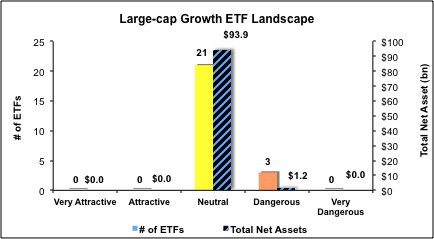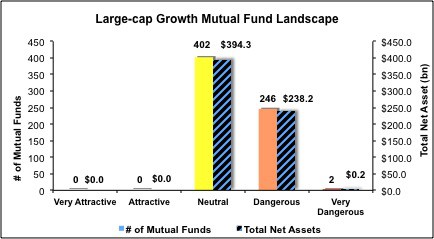The Large Cap Growth style ranks fourth out of the twelve fund styles as detailed in my Style Rankings for ETFs and Mutual Funds report. It gets my Neutral rating, which is based on aggregation of ratings of 24 ETFs and 650 mutual funds in the Large Cap Growth style as of January 27, 2014. Prior reports on the best & worst ETFs and mutual funds in every sector and style are here.
Figures 1 and 2 show the five best and worst-rated ETFs and mutual funds in the style. Not all Large Cap Growth style ETFs and mutual funds are created the same. The number of holdings varies widely (from 17 to 2059), which creates drastically different investment implications and ratings. The best ETFs and mutual funds allocate more value to Attractive-or-better-rated stocks than the worst, which allocate too much value to Neutral-or-worse-rated stocks.
To identify the best and avoid the worst ETFs and mutual funds within the Large Cap Growth style, investors need a predictive rating based on (1) stocks ratings of the holdings and (2) the all-in expenses of each ETF and mutual fund. Investors need not rely on backward-looking ratings. My fund rating methodology is detailed here.
Investors should not buy any Large Cap Growth ETFs or mutual funds because none get an Attractive-or-better rating. If you must have exposure to this style, you should buy a basket of Attractive-or-better rated stocks and avoid paying undeserved fund fees. Active management has a long history of not paying off.
Get my ratings on all ETFs and mutual funds in this style by searching for Large Cap Growth on my free mutual fund and ETF screener.
Figure 1: ETFs with the Best & Worst Ratings – Top 5
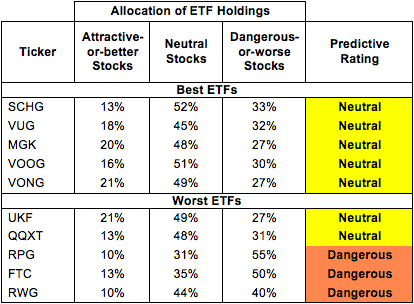
Sources: New Constructs, LLC and company filings
PowerShares RAFI Fundamental Pure Large Growth Portfolio (PXLG) and State Street SPDR SPDR MFS Systematic Growth Equity ETF (SYG) are excluded from Figure 1 because their total net assets (TNA) are below $100 million and do not meet our liquidity standards.
Figure 2: Mutual Funds with the Best & Worst Ratings – Top 5
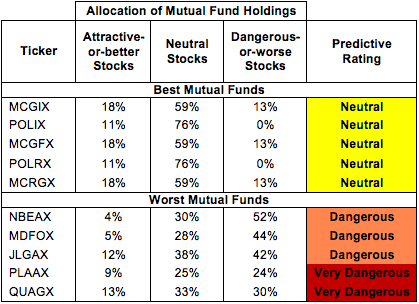
Sources: New Constructs, LLC and company filings
Schwab U.S. Large-Cap Growth ETF (SCHG) is my top-rated Large Cap Growth ETF and Aston Funds: ASTON/Montag & Caldwell Growth Fund (MCGIX) is my top-rated Large Cap Growth mutual fund. Both earn my Neutral rating.
Columbia Select Large Cap Growth ETF (RWG) is my worst-rated Large Cap Growth ETF and Quaker Investment Trust: Quaker Strategic Growth Fund (QUAGX) is my worst-rated Large Cap Growth mutual fund. RWG earns my Dangerous rating and QUAGX earns my Very Dangerous rating.
Figure 3 shows that 145 out of the 933 stocks (over 15% of the market value) in Large Cap Growth ETFs and mutual funds get an Attractive-or-better rating. However, 0 out of 24 Large Cap Growth ETFs and 0 out of 650 Large Cap Growth mutual funds an Attractive-or-better rating.
The takeaways are: mutual fund managers allocate too much capital to low-quality stocks and Large Cap Growth ETFs hold poor quality stocks.
Figure 3: Large Cap Growth Style Landscape For ETFs, Mutual Funds & Stocks
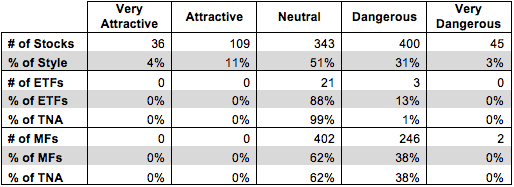
As detailed in “Low-Cost Funds Dupe Investors”, the fund industry offers many cheap funds but very few funds with high-quality stocks, or with what I call good portfolio management.
Investors need to tread carefully when considering Large Cap Growth ETFs and mutual funds, as there are many Dangerous-or-worse rated ETFs and mutual funds. No ETFs and mutual funds in the Large Cap Growth style allocate enough value to Attractive-or-better-rated stocks to earn an Attractive rating. Investors should focus on individual stocks instead.
QUALCOMM Inc. (QCOM) is one of my favorite stocks held by Large Cap Growth ETFs and mutual funds and earns my Attractive rating. QCOM has grown after tax profit (NOPAT) by 41% compounded annually over the last 11 years. The company currently earns a top quintile return on invested capital (ROIC) of 51%. At the current price of ~$74/share, QCOM has a price to economic book value (PEBV) ratio of 1.3. This ratio implies the market expects QCOM to grow NOPAT by no more than 30% for the remaining life of the company. While this may seem high, QCOM has proven over the past decade they have the technology and ability to continue growth in the ever-changing technological scene.
Time Warner, Inc. (TWX) is one of my least favorite stocks held by Large Cap Growth ETFs and mutual funds and earns my Dangerous rating. Over the past 9 years, TWX has not grown after tax profit (NOPAT) at all. TWX earns a bottom quintile return on invested capital (ROIC) of 2%. To make matters worse, TWX has generated negative economic earnings for the past 15 years. Despite the lack of growth by TWX, its stock price has increased ~30% over the past year and is overvalued. TWX’s current valuation of ~$63/share implies that the company will grow NOPAT by 6% compounded annually for 22 years. Such an ambitious growth expectation seems unwarranted for a company with stagnant profits in a cutthroat business.
Figures 4 and 5 show the rating landscape of all Large Cap Growth ETFs and mutual funds.
My Style Rankings for ETFs and Mutual Funds report ranks all styles and highlights those that offer the best investments.
Figure 4: Separating the Best ETFs From the Worst Funds
Figure 5: Separating the Best Mutual Funds From the Worst Funds
Review my full list of ratings and rankings along with reports on all 24 ETFs and 650 mutual funds in the Large Cap Growth style.
Kyle Guske II contributed to this report.
Disclosure: David Trainer owns QCOM. David Trainer and Kyle Guske II receive no compensation to write about any specific stock, sector, style or theme.

